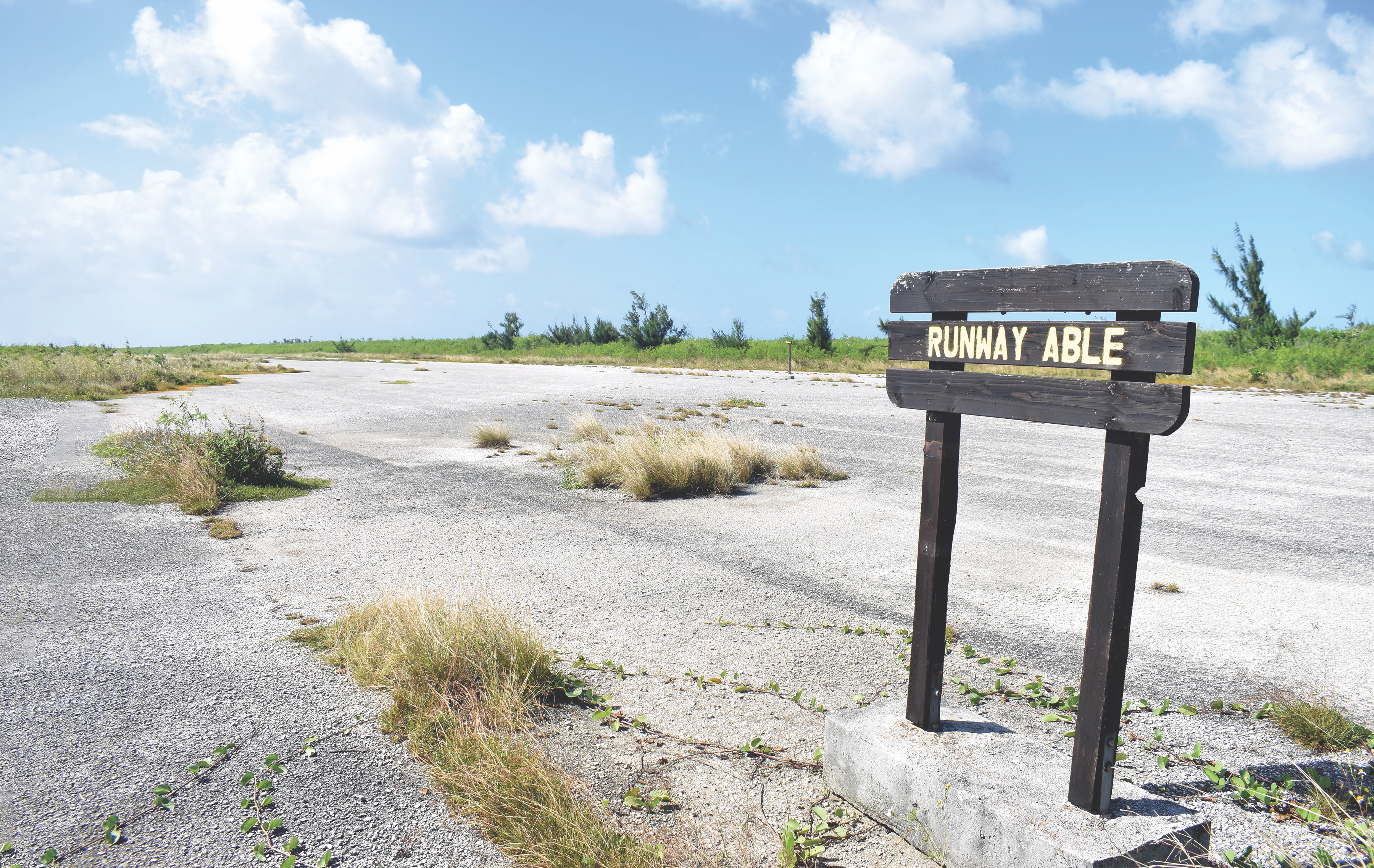WE STOOD AT THE END OF RUNWAY ABLE at the northern tip of Tinian in the Pacific Ocean’s Mariana Islands and looked at a wooden 2×4, not quite seven feet tall, jutting straight up out of the tarmac. An arrow pointed south, to our left, toward the start of the runway. To our right, 100 feet away, the runway ended. Just beyond, a small patch of vegetation kept us from seeing the ocean lapping at Tinian’s shore.
Nearly 75 years earlier—at 2:45 a.m. on August 6, 1945—Colonel Paul Tibbets’s B-29 Enola Gay began its takeoff roll down this very runway. It was weighted down with 7,000 gallons of fuel, two extra crew members, and a 9,500-pound bomb—“Little Boy,” the world’s first atomic weapon destined for a live target.
The heavy load meant Tibbets had to accelerate longer than usual before reaching takeoff speed. Speaking to our group, historian Don Farrell, who lives on Tinian, said, “Tibbets was determined to get that plane in the air,” and that crew members have told him of the incredible tension aboard the bomber. In his memoir, Tibbets described “using every inch of the runway.”
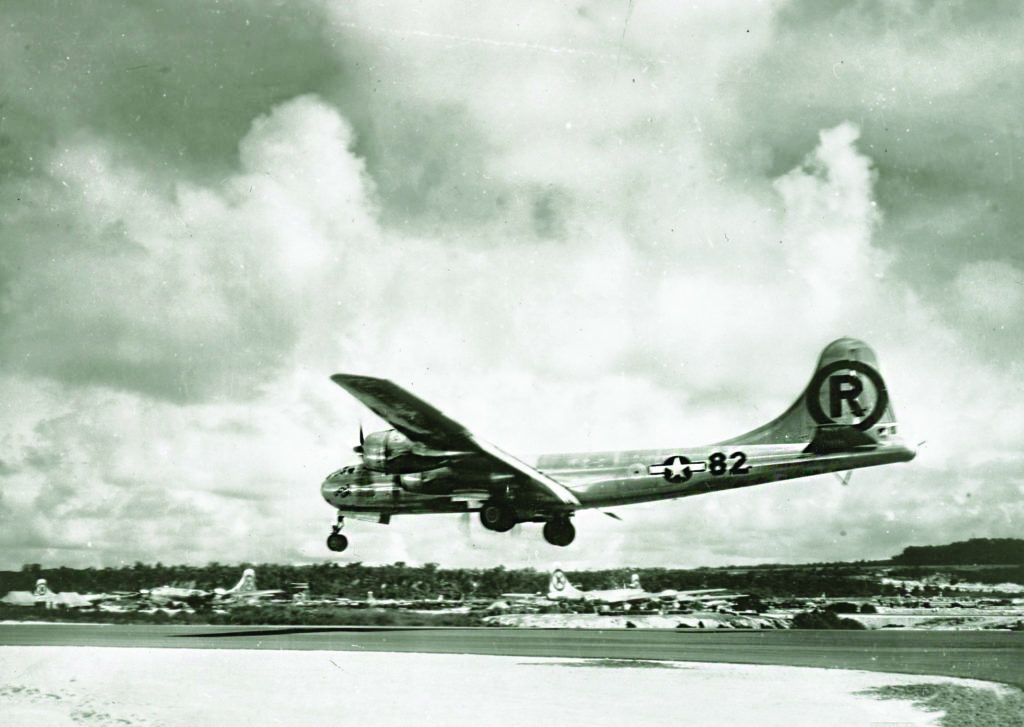
When the plane reached the spot marked by the arrow on the 2×4, its nose lifted. It was airborne, rising above the Philippine Sea. Six and a half hours and 1,570 miles later, Enola Gay dropped its bomb on Hiroshima, Japan, helping to bring an end to World War II, ushering in the nuclear age, and forever changing the course of human history.
I had come to Tinian with my father-in-law, Louis Barker, on a different sort of mission. Louis, 86, wanted to see the remote island where his father, Lloyd Barker, served as a U.S. Navy Seabee in World War II. The Seabees were usually older volunteers with blue-collar skills that the Navy put to work paving roads and tarmacs, erecting buildings, and repairing jeeps, tanks, and planes. Lloyd joined the Seabees at age 36.
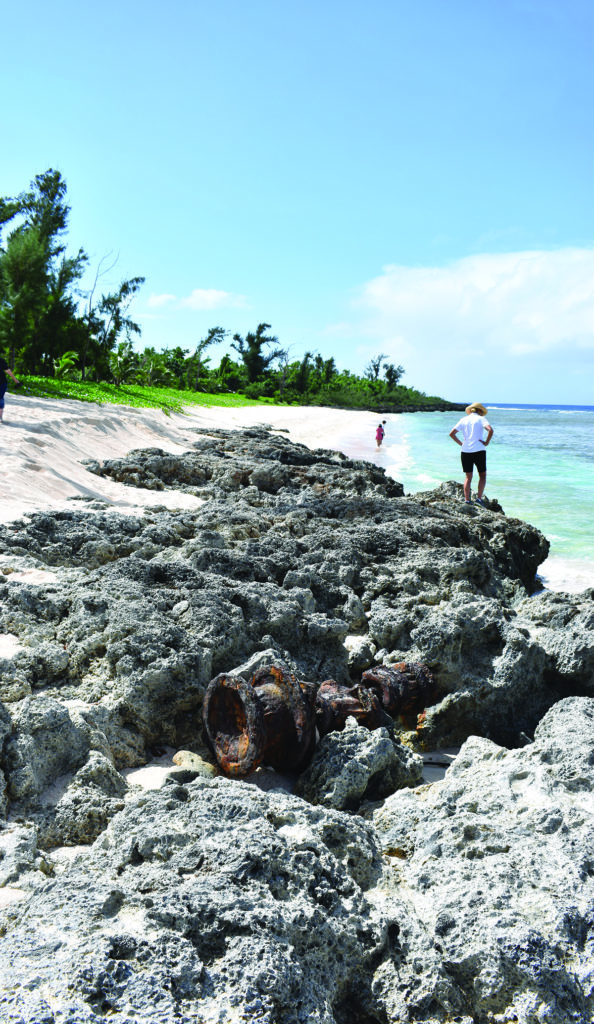
A guided tour around Guam, Saipan, and Tinian greatly added to our understanding of the 1944 fight for the Marianas; these critical victories enabled American B-29 bombers to reach the Japanese homeland. But the trip only allocated half a day on Tinian, which wasn’t enough for us. After the group left the island, we stayed behind, hiring our own tour guide, booking our own hotel, and arranging our return home.
For a tiny island of fewer than 40 square miles, Tinian has a complex history. Its first people, the Chamorro, live on Tinian and the other Mariana Islands to this day. Ferdinand Magellan landed on the islands in 1521, spawning centuries of outside rule. After World War I, Japan temporarily ousted the indigenous people and established a thriving sugar cane industry, which ended as World War II ramped up.
The bloody invasions of Saipan and Guam in June and July 1944 cost many thousands of American and Japanese lives. U.S. military planners chose a different approach for Tinian. They organized a successful diversionary attack, sending two Marine regiments and six warships toward a natural landing spot, a broad harbor near Tinian’s southwestern tip. When the Japanese spotted the Americans cruising past the northern coast on their way from Saipan, all hands raced to the southern harbor to join the fight. As the warships shelled Japanese defenses, Marines boarded landing craft and approached the southern beaches—then returned to their transports and reembarked. Although heavy Japanese shellfire killed 62 and wounded another 223 sailors and Marines, the feint worked perfectly—the defenders were diverted from the actual site of the full-scale invasion: two small beaches in the north.
We visited each of the beaches, and it was easy to see how the Japanese took the bait. At the scene of the diversionary attack, a broad, inviting harbor welcomed the Marines south of what is now downtown San Jose—the only municipality on the island.
Only one Japanese cannon remains in situ on Tinian, at the edge of a cave overlooking the large southern beach. Another local guide, Deborah Fleming, who escorted Louis and me on our second day, took us to see the weathered weapon, aimed for the last 75 years toward the harbor.
The main assault, mounted by Marines of the Fourth Division, soon landed at the lightly defended northern beaches and took over the nearby airfield. It took another week for the Marines, with support from the navy and Army Air Forces, to ultimately rout the remaining Japanese. The U.S. landed 42,000 troops in all, losing fewer than 400 lives and an additional 1,600 wounded. The Japanese lost nearly their entire complement of soldiers—about 9,000.
Once the U.S. took control of Tinian, it made the most of the strategic island. Seventy-five thousand men lived there at its peak. Naval Construction Battalions, made of Seabees like Lloyd Barker, built coral runways that enabled, within a few months, thousands of B-29s to take off on bombing missions, making Tinian the busiest airport in the world.
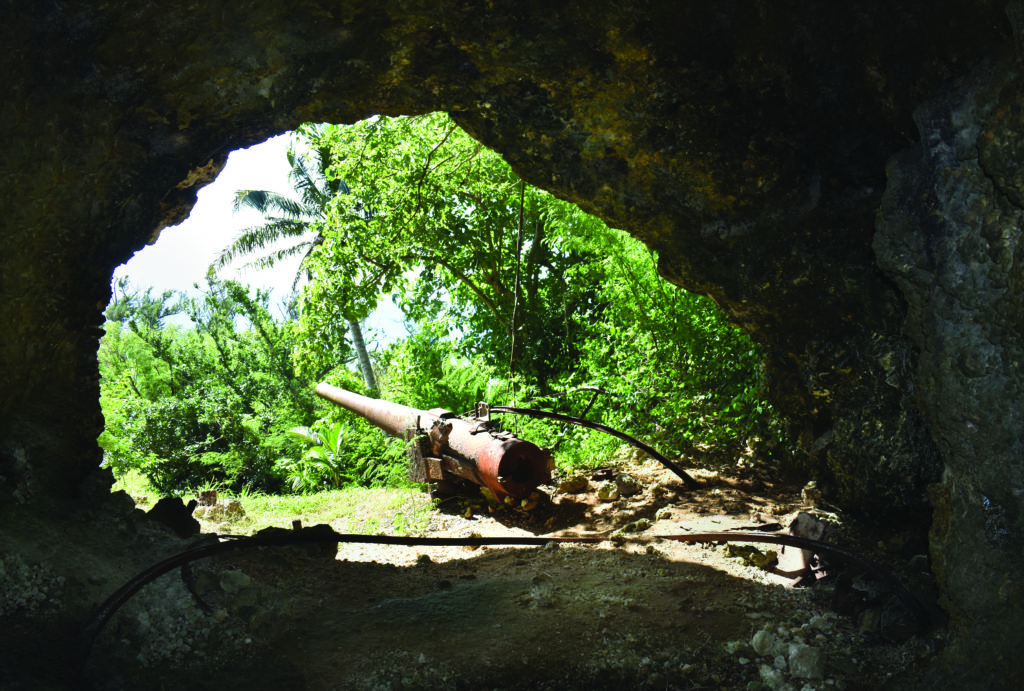
Military planners noted that the island’s size and shape bore a resemblance to another island back in America, between the Hudson and East Rivers. In homage, they laid out a grid of streets that to this day bear the names of those in New York City. Louis has photos of his father mugging for the camera at the intersection of Broadway and 64th Street with nary a skyscraper in sight. Coincidentally, the street names unwittingly foreshadowed Tinian’s most crucial role: as a second home to the top-secret Manhattan Project.
At its peak, the Manhattan Project placed 100 people on Tinian during 1945, including Robert Oppenheimer’s lieutenant, Norman Ramsey. Historian Farrell noted that Ramsey and his team were still finalizing details on how exactly the atomic bomb would work. After we saw the takeoff point at Runway Able, we drove to the runway ’s start and peered into the bomb bays. Hydraulic lifts, just like those that elevate a car so a mechanic can work beneath it, raised the bombs into the planes’ cargo holds.
The bomb pits are among the very few wartime relics remaining on Tinian. If you know where to look, however, you can find things. Tour guide Fleming has the nose of a B-29 that her brother found in the jungle in the 1960s. Out near Runway Able, Fleming also took us to a bombed Japanese fuel depot. When the American shells hit, hundreds of barrels of jet fuel went up in flames. “You can’t imagine the inferno,” she said. The rusted, burned-out barrels still fill the decaying concrete building, now covered in roots and vines like King Louie’s palace in Disney’s 1967 film, The Jungle Book.
Similarly, the foundations or frames of a handful of other buildings also stand, empty shells only hinting at the Japanese or Americans who occupied them. “Time, termites, and typhoons take their toll,” Fleming told us.
The island is sprinkled with a few significant monuments and memorials. Farrell believes the memorial to American servicemen, on Eighth Avenue on the island’s northwest side, was the first erected any where in the world after World War II. There’s a newer memorial to each branch of the service in San Jose, near a Japanese peace memorial.
Of special interest to Louis was the Seabee memorial at Broadway and 84th Street, a spare concrete block with a map of Tinian showing where each Seabee battalion was quartered. A flagpole reconstructed after 2018’s Typhoon Yutu is still missing its pulley and a flag.
Lloyd Barker served in the Seabees’ 38th Naval Construction Battalion. A map in Farrell’s 2018 book, Tinian and the Bomb, revealed that they bunked near 59th Street, not far from Island Command. Fleming took us to the spot; we craned our necks to look past jungle vines over to some tall coconut trees standing on the likely location of Lloyd’s Quonset hut. Nearby was Army Air Forces general Curtis LeMay’s mansion, which Fleming said was opulently decked out with stained glass windows. Now all that marks the spot is a lone plane tree rising from the jungle.
The reference to the mansion, however, jibes with a story Louis remembers his dad telling him. One day in the summer of 1945, Lloyd and other enlisted men noticed an admiral, then another, and then another. While security fears prohibited letting lowly Seabees in on the secret, the presence of those commanders pointed to the imminent launch of the newest, most destructive weapon ever known to humanity, the atomic bomb.
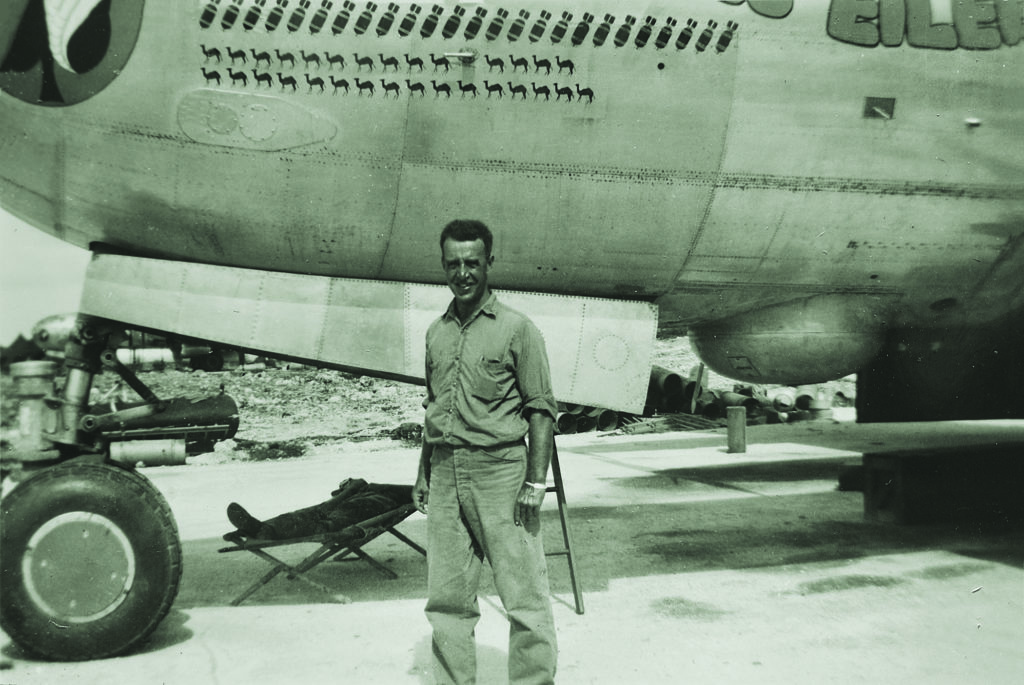
Visiting Tinian proved an emotional experience for Louis. His father died of a heart attack at age 58 in 1963, barely a year after Louis’s daughter—my wife—was born. Standing at the corner of 59th Street and Broadway, staring at an overgrown field once home to scores of Seabees living in Quonset huts, Louis could feel himself in his father’s footsteps. He shed a few tears and was ready to head for home. ✯
WHEN YOU GO
To get to Tinian, you need to travel via Guam or Saipan. From Saipan, the closer option, Star Marianas Air offers numerous daily 15-minute flights for less than $100 on four- or six-seat Cherokees. Travel on Tinian, including tours led by Don Farrell or Deborah Fleming, can be booked through Gordon Marciano (email gordon@pdisaipan.com) at tour company Pacific Development Inc. (Beyond Band of Brothers, the group we toured with, has recently suspended operations.)
Where to Stay and Eat
Tinian offers a few small no-frills hotels: Lorilynn Hotel is clean and comfortable; Tinian Oceanview Hotel is opposite a small beach; and tour guide Deborah Fleming operates the Fleming Hotel. (The hotels can be found on Tripadvisor.) The primary restaurant, JC Café, where we ate all our meals, has offerings ranging from Chinese food to standard American diner fare. We also bought food at one of several small markets in San Jose.
What Else to See and Do
Along with the wartime sites, Tinian features several coastal blowholes and outstanding snorkeling and scuba diving. The island makes an excellent side trip from Guam and Saipan, which have well-developed tourist infrastructures; the War in the Pacific National Historical Park has outposts on both.
This article was published in the August 2020 issue of World War II.

